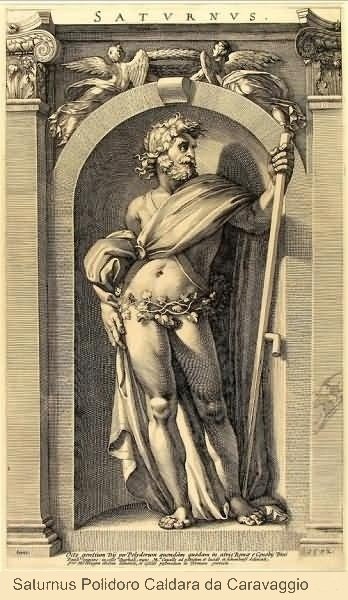
Saturn
An ancient Italian god, identified with the Greek Cronus and the Near Eastern Baal, but he also had all the attributes of Demeter. The worship of Saturn focused strongly on the Saturnalia, or festival of Saturn, held each year at the end of December. This was a happy celebration involving role reversal, where masters took orders from their slaves.

From about the fourth century AD these celebrations became assimilated into those of New Year's Day and Christmas. The temple of Saturn, on the Capitoline Hill, was used as a treasury.
Saturn was the god who civilized Italy, teaching cultivation, following on from Janus. This is reflected in artistic representations which show Saturn with a scythe. With agriculture central to the wealth of Italy, it was natural for him to be regarded as the god of plenty; he ruled over a Golden Age and then suddenly disappeared, in the way of mythical kings.
From Smith's Dictionary of Greek and Roman Biography and MythologyFrom Roman Antiquities and Ancient Mythology
There are two other temples, particularly worth notice, not so much for the magnificence of the structure, as for the customs that depend upon them, and the remarkable use to which they were put. These are the temples of Saturn and Janus.
The first was famous on account of serving for the public treasury—the reason of which some fancy to have been because Saturn first taught the Italians to coin money; but most probably it was because this was the strongest place in the city. Here were preserved all the public registers and records, among which were the libri elephantini, or great ivory tables, containing a list of all the tribes and the schemes of the public accounts.
The other was a square building, some say of entire brass, so large as to contain a statue of Janus, five feet high, with brazen gates on each side, which were kept open in war, and shut in time of peace.
From The Christ by John E. Remsberg
Among the life generating gods may be named Vishnu, Osiris, Zeus, Priapus, Adonis, Bacchus, Saturn, Apollo, Baal, Moloch, and Jehovah. Among the receptive life producing goddesses were Isis, Rhea, Ceres, Venus, Istar, Astarte, Aschera, Devaki, Eve, and Mary. Where the worship of the female element largely prevailed the Virgin and Child was a favorite deity. Isis and Hortrs, Rhea and Quirinus, Leto and Apollo, Devaki and Krishna, Mary and Christ, all had their inception in the sex worship of primitive man.
From Metamorphoses by Ovid. Book The First
The Silver Age
But when good Saturn, banish'd from above,
Was driv'n to Hell, the world was under Jove.
Succeeding times a silver age behold,
Excelling brass, but more excell'd by gold.
Then summer, autumn, winter did appear:
And spring was but a season of the year.
The sun his annual course obliquely made,
Good days contracted, and enlarg'd the bad.
Then air with sultry heats began to glow;
The wings of winds were clogg'd with ice and snow;
And shivering mortals, into houses driv'n,
Sought shelter from th' inclemency of Heav'n.
Those houses, then, were caves, or homely sheds;
With twining oziers fenc'd; and moss their beds.
Then ploughs, for seed, the fruitful furrows broke,
And oxen labour'd first beneath the yoke.
From The Non-Christian Cross, by John Denham Parsons
If we seek for that origin as a combination of the first two letters of some other Greek word than Christos, Christ, and for the moment assume the letters Ρ and Χ to have occurred in the same order as in that word, we see at once that the monogram may have been derived either from the word Chrestos, Good, or the word Chronos, Time, or the word Chrusos, Gold.
There is, by the way, another curious connection between the three Greek words in question. For the name of the famous god Kronos or Cronos was often spelt ΧΡΟΝΟΣ i.e., Chronos. And this god Chronos—the father of Zeus; and more or less a personification of Time, the Old Father from whom we are all descended—was identical with Saturn, while the Saturnian Age was, as in Virgil's fourth eclogue, ever that spoken of as the Golden age when the ancients were referring to what they pictured as the good old times.
